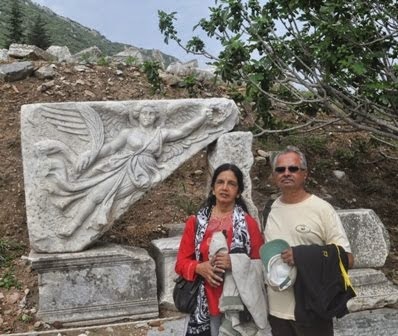Udayagiri and
Khandagiri Caves are situated about 10 kms. from Bhubaneswar. These are partly
natural and partly artificial caves of archaeological, historical and religious
importance near the city of Bhubaneswar in Odisha, India. The caves are situated on two adjacent hills, Udayagiri and
Khandagiri mentioned as Kumari Parvata in the Hathigumpha inscription. They have a number of finely and ornately carved caves built
during the 1st century BCE. It is believed that most of these caves were carved
out as residential blocks for Jaina monks during the reign of King Kharavela. Udayagiri means "Sunrise Hill" and has 18 caves while
Khandagiri has15 caves.
The caves of
Udayagiri and Khandagiri, called Lena in inscriptions, were dug out mostly during the reign of Kharavela for the abode of Jaina ascetics. The most important of this
group is Ranigumpha in Udayagiri which is a double storeyed monastery. Another
important cave is Hathi Gumpha
The caves of
Udayagiri and Khandagiri, called lena in inscriptions, were dug out mostly during the reign of Kharavela for the abode of Jaina ascetics. The most important of this
group is Ranigumpha in Udayagiri which is a double storeyed monastery. Another
important cave is Hathi Gumpha
Rani Gumpha is the largest and most popular
cave among the caves of Udayagiri and Khandagiri. The word 'Rani' means
Queen. Although it is not an architectural marvel, it has some ancient
beautiful sculptures.
This cave is double storeyed. Each storey has
three wings and the central wing is bigger among all the three wings. The lower
floor has seven entrances in the middle wing whereas the upper floor has nine
columns. The upper portion of the central wing has relief images depicting the
victory march of a king. Many of the cells have carved dwara
pala images; some of them are disfigured. The area that connects the
central wing with right and left wings have some panels where the sculptures of
wild animals, fruit-laden trees, human figures, women playing musical
instruments, monkeys and playful elephants are found. The pilasters contain
the toranas (arches) decorated with sculptures of Jain religious
importance and royal scenes.
Cave No.10. Ganesha
Gumpha
Ganesha Gumpha is one of the most important
caves in Udayagiri. The cave got this name due to the carved figure of Ganesha on
the back of its right cell. Of course, it would have been carved in the later
period and it cannot be the original work. The cave has two big statues of
elephants carrying garlands at the entrance and is the first example of
sculpture animals used as a guard to the entrance. Also, the carved figures
of dwara palas are found at the entrances. The carvings in this cave
narrate the story of the elopement of Bassavadatta, Princess of Ujjayini, with
King Udayana of Kausambi in the company of Vasantaka.
Entry
Fee: Rs.25 for Indians and Rs.300 for
foreigners
Timing. The
caves are open throughout the day.
Guides:
Authorised guides are available and will charge Rs.300 for Khandagiri alone and
Rs.500 for both Khandagiri and Udaigiri.
SHANTI STUPA DHAULAGIRI
Dhauli
hill is presumed to be the area where the Kalinga
War was fought. Rock Edicts are
found here and two separate Kalinga Edicts. In Kalinga, he expresses his concern for the
"welfare of the whole world". The rock-cut elephant above the Edicts
is the earliest Buddhist sculpture
of Odisha. The stone elephant shows the animal's foreparts only, though it has
a fine sense of form and movement. It is considered as one of the few remains
of Mauryan
art. Ashoka had a special weakness for Dhauli, where the battle was fought.
The Daya river is
said to have turned red with the blood of the many deceased after the battle,
and enabled Ashoka to realize the magnitude of horror
associated
with war. He saw to it that Dhauli became an important centre of Buddhist
activities. He built several chaityas, stupas and pillars there. He
instructed that hermitages be excavated where recluses could meditate, issued
instructions to be inscribed for officials expounded the main principles
of dandaniti (strict enforcement of laws) for the public, and thereby
provided special status to his new kingdom including the stupas at Dhauli. On
the top of the hill, a dazzling white peace pagoda has been built by
the Japan Buddha Sangha and the Kalinga Nippon Buddha
Sangha in the 1970s.
The rock edict is located near the historical sight of the Kalinga war which is said to have transformed
Samrat Ashok. In these
inscriptions, Ashoka refers to himself as "Beloved servant of
the Gods" (Devanampiyadasi). The inscriptions revolve around a few
recurring themes: Ashoka's conversion to Buddhism, the description of
his efforts to spread Buddhism, his moral and religious precepts, and his
social and animal welfare programme.


















































